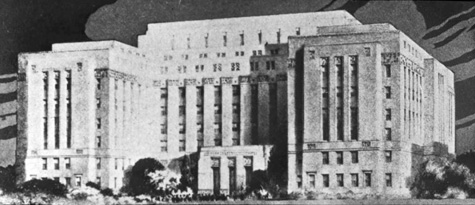Jefferson County Courthouse: Difference between revisions
No edit summary |
|||
| Line 22: | Line 22: | ||
* "Courthouse remains. City's Wall of Jericho" (April 26, 1982) {{BPH}} | * "Courthouse remains. City's Wall of Jericho" (April 26, 1982) {{BPH}} | ||
* Bowsher, Alice M. (July 28, 1982) "[http://focus.nps.gov/pdfhost/docs/NRHP/Text/82001606.pdf Jefferson County Courthouse]" National Register of Historic Places Inventory—Nomination Form. | * Bowsher, Alice M. (July 28, 1982) "[http://focus.nps.gov/pdfhost/docs/NRHP/Text/82001606.pdf Jefferson County Courthouse]" National Register of Historic Places Inventory—Nomination Form. | ||
* Gordon, Tom (1991) "Ancient sign, modern meaning: Historians say those courthouse swastikas are just decorative." {{BN}} | |||
* Rockett, Julie (September 22, 2015) "NAACP to address Jefferson Co. Courthouse mural." WBRC.com | * Rockett, Julie (September 22, 2015) "NAACP to address Jefferson Co. Courthouse mural." WBRC.com | ||
* Vollers, Anna Claire & Ivana Hrynkiw (January 12, 2020) "Jefferson County to preserve remains of jail that once held Martin Luther King, Jr." {{BN}} | * Vollers, Anna Claire & Ivana Hrynkiw (January 12, 2020) "Jefferson County to preserve remains of jail that once held Martin Luther King, Jr." {{BN}} | ||
Revision as of 09:15, 1 July 2020
- This article is about the 1932 courthouse at Linn Park. For other uses, see Jefferson County Courthouse (disambiguation).
The Jefferson County Courthouse is the seat of government for Jefferson County. It is the county's third courthouse. The cornerstone was laid in 1929, and the buildng was completed in 1932.
The courthouse occupies most of Block 22, on the east side of Linn Park, anchoring downtown Birmingham's "municipal center". Its address is 716 Richard Arrington Jr Boulevard North (formerly 21st Street North)
The design for the courthouse was commissioned by the county from the Chicago, Illinois firm of Holabird & Root, and was principally the work of Birmingham-born Jack B. Smith, with the Birmingham-based architect Harry Wheelock acting as an associate. The reinforced concrete building is clad with granite and limestone in an streamlined Art Deco style. The architects hired Leo Friedlander to design the sculpted relief panels near the roof line. Another Chicago artist, John Norton, painted the large murals depicting the "Old South" and "New South" on either end of the entrance lobby.
A 1962 annex to the north of the original building was designed in a complementary style by Charles McCauley. The former prisoner holding area on the 7th floor was reconfigured to house storage and mechanical equipment in the 1990s, leaving two holding cells intact. A restoration and refitting of the entire building was completed in 2002 under the direction of Giattina Fischer Aycock.
The building was added to the National Register of Historic Places in 1982. The two remaining jail cells have been preserved, partly as a memorial to Martin Luther King Jr, who, along with his brother A. D. King and others were held there for three days in October 1967 to face outstanding contempt of court charges from the 1963 Birmingham Campaign.
Controversies
Some elements of the courthouse's original decorative scheme have raised objections over the years. Geometric designs resembling swastikas on the granite walls of the outside steps at the east entrance were carved between 1928 and 1931. By that time, Germany's Nazi party had adopted a similar swastika on their flag, but it was still several years before the American public would have made any connection between the symbol and the Third Reich. Such designs, whether intended as symbols, as emblems of Native American culture, or merely as geometric ornament, were incorporated into several public buildings in that era, including the U.S. Post Office in Reno, Nevada (1932) and the Federal Reserve Building in Washington D.C. (1937).
The depiction of black slaves and miners as secondary figures at the feet of the heroically-sized white figures in John Norton's "Old South" and "New South" murals has also been criticized in recent years as examples of racism implicit in 1930s society. Consideration of removing or covering the murals was taken up by the County Commission in 2015.
References
- "Courthouse is Emblematic of County" (May 24, 1931) Birmingham Age-Herald
- White, Marjorie Longenecker (1977) Downtown Birmingham: Architectural and Historical Walking Tour Guide. Birmingham: Birmingham Historical Society.
- "Courthouse remains. City's Wall of Jericho" (April 26, 1982) Birmingham Post-Herald
- Bowsher, Alice M. (July 28, 1982) "Jefferson County Courthouse" National Register of Historic Places Inventory—Nomination Form.
- Gordon, Tom (1991) "Ancient sign, modern meaning: Historians say those courthouse swastikas are just decorative." The Birmingham News
- Rockett, Julie (September 22, 2015) "NAACP to address Jefferson Co. Courthouse mural." WBRC.com
- Vollers, Anna Claire & Ivana Hrynkiw (January 12, 2020) "Jefferson County to preserve remains of jail that once held Martin Luther King, Jr." The Birmingham News
External links
- 3-D model of the Jefferson County Courthouse by Jordan Herring
